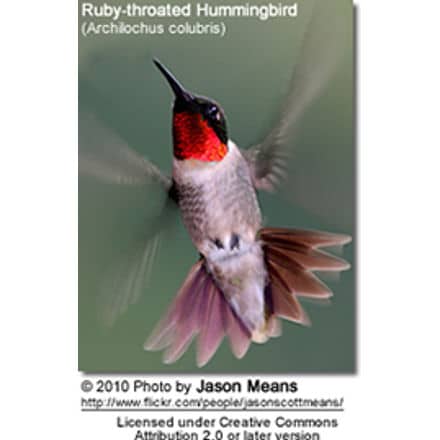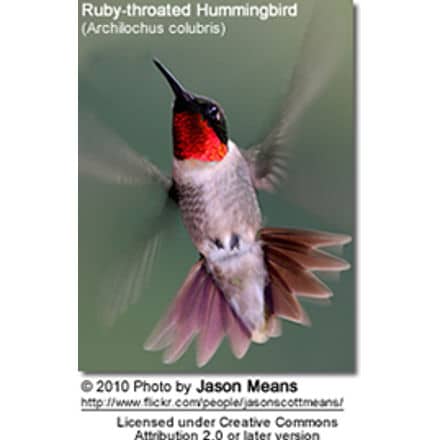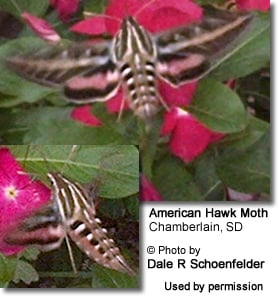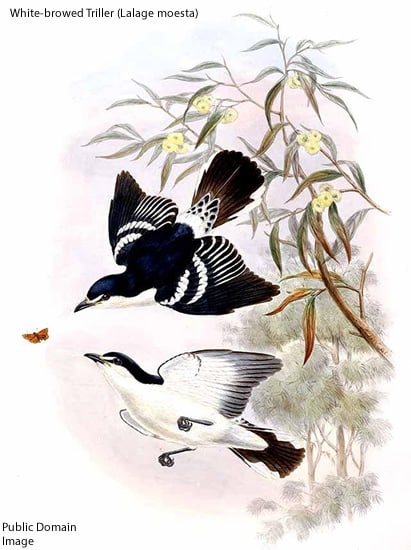Hummingbirds found in Nebraska, USA
Hummingbirds found in the USA (by U.S. State) … Canada … Mexico … Puerto Rico … Jamaica … Honduras
Hummingbird Information … Hummingbird Species Photo Gallery
The following 4 hummingbird species are known to occur in Nebraska.
Most migratory hummingbirds arrive in Nebraska between April to May for the nesting season.
Ruby-throated Hummingbirds, Archilochus colubris – It is the most likely hummingbird species to be seen in Nebraska – and it is the ONLY hummingbird species that occurs in the eastern half of the state, where they often nest along the Missouri River. However, nests have been reported as far west as North Platte. They have been reported as far west in Nebraska as Scotts Bluff County.
They usually arrive early to mid-May and leave in mid-September to early October to return to their winter territories. Migrating males are usually the first to arrive and the first to depart. The females and juveniles usually follow about two weeks later.
The male has a ruby-red throat, a white collar, an emerald green back and a forked tail.
The female has a green back and tail feathers that are banded white, black and grey-green.


Rufous Hummingbirds, Selasphorus rufus – Rare and Casual – Occasionally stray into western Nebraska during fall migration.
These hummingbirds are usually found in gardens and at feeders. These birds are fearless, and are known for chasing away other hummingbirds and even larger birds, or rodents away from their favorite nectar feeders and flowers.
Males can easily be identified by their glossy orange-red throats.
Females have whitish, speckled throats, green backs and crowns, and rufous, white-tipped tail feathers.
Rufous Hummingbird versus the similar Ruby-throated Hummingbird (Identification)
Broad-tailed Hummingbirds, Selasphorus platycercus – Rare – Have been observed in Dawes and Scotts Bluff counties.
Males can most easily be identified by their iridescent, rose-red throats, white chest feathers and metallic green back and crown and their rounded tails. The males’ tails make whistling noises in flight.
Females lack the flashy throat patch of the male and are mostly pale below. Their white-tipped outer tail feathers are rust-colored close to the body and blackish in the center; the tail feathers in the center range from green to blackish.


Calliope Hummingbirds, Stellula calliope – Accidental Vagrant – The rarest hummingbird species to occur in Nebraska. They are common breeders in western Wyoming, and occasionally stray into Nebraska.
The smallest breeding bird in North America. It weighs as little as a penny! It is the smallest long distant migrant bird in the world – traveling as far as 9,000 km (5,600 miles) from the cold and harsh higher elevations of the western United States and Canada, to winter in southern Mexico. They tend to be less aggressive than the larger hummingbirds, and typically feed low in the flowers and away from the more aggressive hummingbird species.
The upper plumage of both males and females is mostly a glossy green and below creamy white. Relatively short tail and beak. Males have a white throat with iridescent elongated gorget (throat) feathers that form wine-red or purple streaks and — when erected – show a “whiskered” effect. Females can be identified by their whitish throats with dark streaks.
They are most easily confused with the Rufous Hummingbirds and the Broad-tailed Hummingbird.

Is it a Hummingbird or an Insect?
The Hawk Moths (often referred to as “Hummingbird Moth”) is easily confused with hummingbirds, as they have similar feeding and swift flight patterns. These moths also hover in midair while they feed on nectar.
Moths have a couple of sensors or “antennas” on top of the head, which are key identifiers.
Attract Hummingbirds to YOUR Garden!!
The favorite feeding plants Iowa Hummingbirds are:
Many hummingbirds favor red blossoms with a tubular shape (but some species prefer other colors). Hummingbirds feed readily on pink, blue, orange, peach and purple flowers.
- Anise Sage (Salvia guaranitica) – blue flowers. One of hummingbird favorites. Also: Salvia pensetmonoides
- Hummingbird Mints — (Agastache cana and Agastache rupestris / Agastache ‘Acupulco Salmon and Pink’ ) – Perennial; grows quickly; very fragrant.
- Flowering Maple (Abutilon sp.) – Not cold resistant. Only survives the winter if brought indoors. A prolific bloomer with lots of nectar. A favorite feeding plant.
- Trumpet honeysuckle (Lonicera sempervirens)
- Texas Sage (Salvia coccinea), Salvia ‘Maraschino’ (Bush Salvia)
- Red Hot Poker (Tritoma)
- Bee Balm (Monarda)
- Penstemon barbatus
- Crocosmia ‘Lucifer’
Others:
- Crabapple and Sargent crabapple are hummingbird favorites
- Cross Vine (Bignonia capreolata) – evergreen. Orange-red flowers bloom during May and June.
- Corsage – an evergreen (Azalea cultivar) produces lavender blooms
- Wild red columbine (Aquilegia canadensis)
- Cardinal flower (Lobelia cardinalis)
- Day Lilies, Columbine, Sweet William, Common Foxglove, Hosta, Coral Bells and Shasta Daisy



